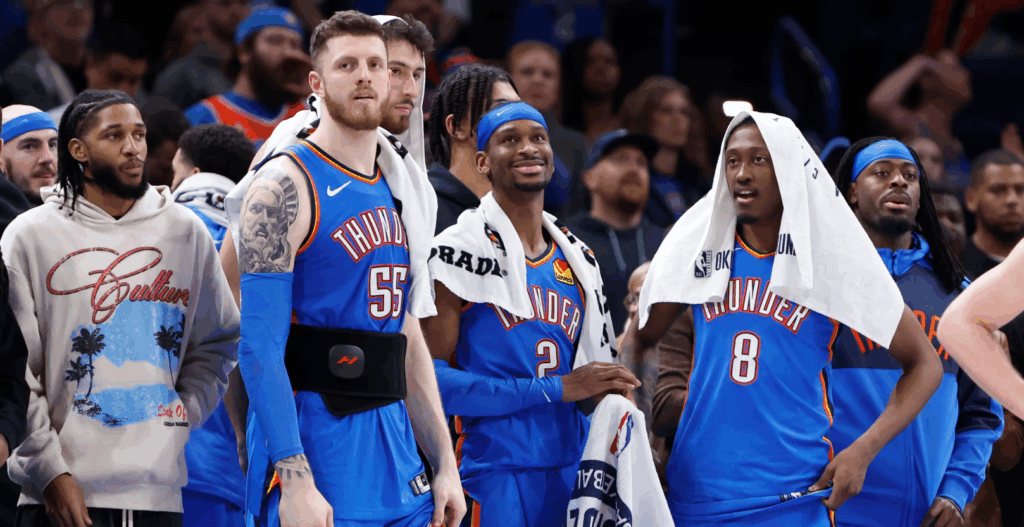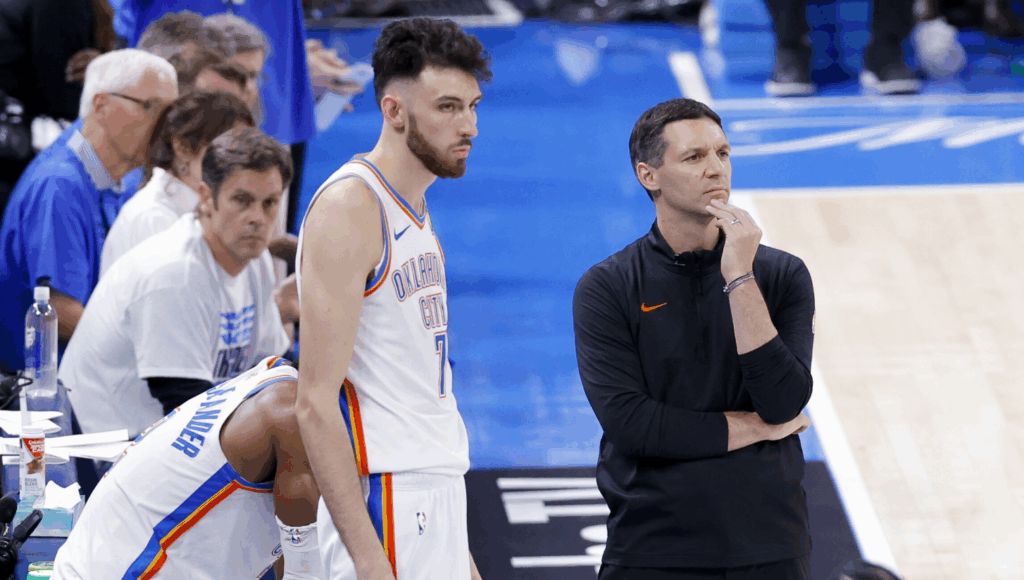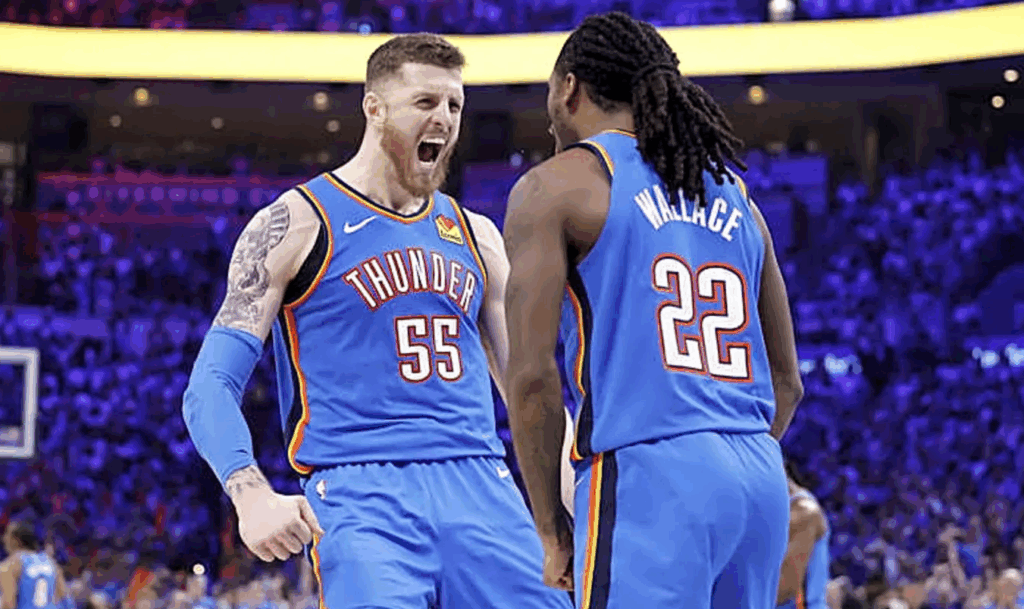You’ve watched young teams crumble under championship expectations before. The Thunder weren’t supposed to be different. Yet here they are, hoisting the Larry O’Brien Trophy after silencing every critic who questioned their readiness. What separated them from past pretenders?
It wasn’t just talent or luck. OKC Thunder discovered something deeper in those pressure-packed moments that transformed doubt into fuel.
The High Expectations and Mounting Pressure
When you look at the OKC Thunder’s championship journey, you can’t ignore the crushing weight of expectations they carried from day one.
Critics doubted whether this young roster possessed the championship mindset needed to overcome experienced Western Conference titans. Analysts question their mental toughness and ability to handle playoff pressure.
The team’s average age of 24.3 made them the youngest squad favored to win it all. Every loss sparked debates about their readiness. Yet behind closed doors, their coaching strategy focused on building unshakeable team chemistry. They embraced the doubters’ noise, using it as fuel.
Veterans mentored rookies through pressure-packed moments. Practice sessions emphasized situational awareness and composure. This foundation proved essential when they’d later face elimination games and hostile road environments throughout their historic run.

Turning Points in the Regular Season
The Thunder didn’t start the season looking like champions, but somewhere along the way, everything started to fall into place. That wild December comeback against Denver wasn’t just a win. It lit the spark that led to a 15-game streak and proved this team had real playoff toughness long before the postseason even began.
Then there was the 40-point blowout over the Lakers. That wasn’t just dominance. It was a message to the league that OKC’s young core was ready to contend and not just show up.
After the All-Star break, things shifted again. Role players grew into steady contributors, and the bench began to look like a strength. The comeback win over Boston in March, where they wiped out a 20-point deficit, showed they could stay composed under championship-level pressure.
These weren’t just regular-season highlights. They were building blocks of something bigger. Every comeback and every gritty win laid the foundation for the belief that would carry them through June.
Coaching Brilliance Under Fire
How did Mark Daigneault transform from the league’s youngest coach to a championship mastermind? You’d find the answer in his fearless strategic decisions throughout the playoffs. When facing elimination, Daigneault’s coaching staff made bold playoff adjustments that stunned opponents. They’d switch defensive schemes mid-game, turning high-pressure moments into opportunities for counterattacks.
You couldn’t ignore how Daigneault mastered tempo control, slowing games when needed and pushing pace to exploit mismatches. He’d bench stars for role players without hesitation, trusting his system over reputation. His timeout usage became legendary, which he perfectly times to halt opponent runs or set up game-winning plays. While other coaches crumbled under pressure, Daigneault’s calm demeanor infected his team.
You’re watching a coach who turned inexperience into unpredictability, making the Thunder impossible to game-plan against.

The Players Who Delivered When It Counted
Clutch moments define champions, and OKC’s stars proved they belonged on basketball’s biggest stage. You saw players rise to the occasion when it mattered most. In the NBA Finals, they didn’t just put points on the board. They dictated pace, locked down on defense, and came through again and again when the game was on the line.
Their defense in crunch time? Smothering. They closed out quarters like seasoned champs. Role players who’d been hit-or-miss all season suddenly lit it up like they’d been waiting their whole lives for that moment. That’s the kind of shift that takes a team from being good to building something special.
When the pressure peaked, OKC’s core stayed ice cold. They attacked the right matchups, hit the open man, and hit the glass like their season depended on it. Every play mattered, and they played like they knew it.
Surviving the Western Conference Gauntlet
Individual brilliance meant nothing without conquering the West’s brutal playoff bracket. You watched OKC’s postseason run unfold like a war of attrition, each series testing their championship mettle differently. The first round brought physicality, the second demanded offensive adjustments, but nothing compared to the Western Conference Finals drama.
That Game 7 victory? You’ll remember it forever. Down by 15 entering the fourth quarter, OKC’s defense clamped down while their offense exploded for 38 points. They’d survived three elimination games just to reach that moment.
Each series revealed new dimensions of this team’s character. When injuries struck key rotational players, others stepped up. When opponents adjusted, OKC counter-adjusted faster. OKC earned the Larry O’Brien Trophy by battling through the gauntlet of the NBA championship series.

NBA Finals Breakdown
Seven games of pure basketball theater defined OKC’s championship destiny. You watched them execute flawlessly when the stakes peaked. Game 1’s defensive masterclass set the tone. They held opponents to 89 points. Games 2 and 3 showcased their offensive versatility, mixing pace changes with surgical half-court sets.
The pivotal Game 5 turnaround remains legendary. Down 15 entering the fourth, OKC triggered a 38-18 quarter. You couldn’t look away as role players hit timely threes while stars controlled tempo.
Game 7’s closing minutes proved their growth. No panic, just methodical execution. They switched everything defensively, forced contested shots, and capitalized on the shift.
Their Finals strategy was simple yet brilliant: control pace, win the glass, trust the system. When pressure mounted, they didn’t flinch. They’d prepared for this moment all season.
Leadership, Brotherhood, and Team Identity
Three veterans pulled this young roster together when doubts crept in. You’d see them huddled with younger players after tough losses, preaching patience and process. Their leadership was consistent. Every practice, every film session, they’d reinforce the team’s identity, which is defense first, share the ball, and trust each other.
You couldn’t miss how the brotherhood manifested on the court. Players celebrated each other’s success genuinely. When someone struggled, teammates picked them up immediately. They’d developed an unspoken communication that only comes from a genuine connection.
Behind closed doors, they’d created their own culture. No ego battles. No finger-pointing. Just accountability and support. That’s why they’d stay composed in hostile arenas and fourth-quarter deficits.
What This Win Means for the Future of OKC
When you watch championship teams throughout history, you’ll notice the ones that sustain success share common traits, and OKC’s demonstrated all of them. They’ve built depth beyond their stars, developed a winning culture, and mastered adaptability under pressure.
This title changes everything for the franchise. You’re looking at a team that proved they can compete with anyone, anywhere. The young core’s gained invaluable playoff experience, and they’ll enter next season with supreme confidence. Free agents will now view OKC as a destination, not a stepping stone.
The Thunder’s championship blueprint is elite defense, unselfish ball movement, and clutch execution. This principle isn’t going away. They’ve got the cap space to improve and the leadership to maintain their edge. You’re witnessing the birth of a potential dynasty in small-market Oklahoma City.
Frequently Asked Questions
What Was the Thunder’s Playoff Record at Home Versus Away?
You’ll find playoff teams typically perform better at home due to crowd energy and familiar surroundings. Away games test resilience as you’re facing hostile environments. Home court advantage usually translates to winning percentages around 60-70% versus 40-50% on the road.
How Much Did the Championship Run Impact the Local Oklahoma City Economy?
You’d be amazed how championship runs boost local economies. Oklahoma City saw millions in revenue from packed restaurants, hotels, and merchandise sales. Local businesses reported 40-60% increases during playoff games, creating jobs and community pride.
Which Former Thunder Players Congratulated the Team After Winning?
You’d be touched seeing Kevin Durant, Russell Westbrook, and James Harden’s heartfelt social media posts. They’ve shown nothing but love for their former team. Paul George and Serge Ibaka also shared emotional congratulations, celebrating OKC’s triumph.
What Specific Injuries Did Key Players Overcome During Playoffs?
Chet Holmgren missed over three months after suffering a fracture to his right iliac wing in November. Jaylin Williams dealt with a right hamstring strain during the preseason. Nikola Topić remained sidelined for the entirety of the playoffs after undergoing season-ending knee surgery. Aaron Wiggins missed about five games in late March due to an Achilles injury.
How Did Thunder’s Championship Odds Change Throughout the Season?
You’d have watched their odds skyrocket from +2500 longshots in October to +450 favorites by Finals time. Early season struggles had them at +4000, but after the All-Star break, they became betting darlings.





